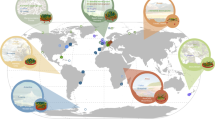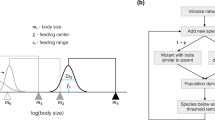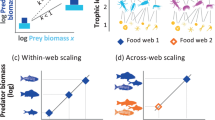Abstract
IN trying to understand the structure of ecological communities, ecologists usually pay particular attention to the interactions between pairs, or small groups of species1. Questions about the ‘shape’ of the food webs within which these species are embedded are much more rarely asked2–4. For example, what happens when a population feeds at more than one trophic level (omnivory)? In some real food webs there seem to be no omnivores (Fig. 1a)5; in others omnivores are common6,7 (Fig. 1c)8. In this note we attack the problem of omnivory using simple, linear Lotka–Volterra models of food webs9, and show that certain patterns are much more likely to persist on an evolutionary time scale than others. We then compare the model predictions with real food webs.
This is a preview of subscription content, access via your institution
Access options
Subscribe to this journal
Receive 51 print issues and online access
$199.00 per year
only $3.90 per issue
Buy this article
- Purchase on Springer Link
- Instant access to full article PDF
Prices may be subject to local taxes which are calculated during checkout
Similar content being viewed by others
References
May, R. M. (ed.) Theoretical Ecology, Principles and Applications (Blackwell, Oxford, 1976).
Watt, K. E. F. Ecology and Resource Management (McGraw-Hill, New York, 1968).
May, R. M. Stability and Complexity in Model Ecosystems (Princeton University Press, 1973).
Cohen, J. E. Proc. natn. Acad. Sci. U.S.A. 74, 4533–4536 (1977).
Richards, O. W. J. Ecol. 14, 244–281 (1926).
Paine, R. T. Ecology 44, 63–73 (1963).
Askew, R. R. Parasitic Insects (Heinemann, London, 1971).
Force, D. C. Science 184, 624–632 (1974).
Pimm, S. L. & Lawton, J. H. Nature 268, 329–331 (1977).
Beddington, J. R., Free, C. A. & Lawton, J. H. J. Anim. Ecol. 45, 791–816 (1976).
Hassell, M. P. The Dynamics of Arthropod Predator-Prey Systems. (Princeton University Press, 1978).
Lawton, J. H. & Pimm, S. L. Nature 279, 190 (1978).
Wynne-Edwards, V. C. Animal Dispersion in Relation to Social Behaviour (Oliver and Boyd, Edinburgh, 1962).
Pimm, S. L. & Lawton, J. H. (in preparation).
Cohen, J. E. Food Webs and Niche Space (Princeton University Press, 1978).
Paine, R. T. Am. Nat. 100, 65–75 (1966).
Kowalski, R. J. Anim. Ecol. 46, 471–482 (1977).
Beddington, J. R. & Hammond, P. S. J. Anim. Ecol. 46, 811–821 (1977).
Anderson, R. M. & May, R. M. J. Anim. Ecol. 47, 219–247 (1978).
Anderson, R. M. in Population Dynamics (eds Anderson, R. M., Taylor, L. R. & Turner, B. D.) (Blackwell, Oxford, in the press).
Author information
Authors and Affiliations
Rights and permissions
About this article
Cite this article
PIMM, S., LAWTON, J. On feeding on more than one trophic level. Nature 275, 542–544 (1978). https://doi.org/10.1038/275542a0
Received:
Accepted:
Issue Date:
DOI: https://doi.org/10.1038/275542a0
This article is cited by
-
Extreme predation of eggs and hatchlings for loggerhead turtles in eastern Indian Ocean
Biodiversity and Conservation (2024)
-
Food web restoration lags behind biological communities: a case study from a floodplain wetland
Hydrobiologia (2024)
-
Trophic niche diversity and redundancy across trophic positions in a subtropical river fish assemblage
Hydrobiologia (2024)
-
Interpreting random forest analysis of ecological models to move from prediction to explanation
Scientific Reports (2023)
-
Multi-Spatial-Scale Factors Determining the Abundance of Frogs in Rice Paddy Fields and Their Potential as Biological Control Agents
Wetlands (2023)
Comments
By submitting a comment you agree to abide by our Terms and Community Guidelines. If you find something abusive or that does not comply with our terms or guidelines please flag it as inappropriate.



